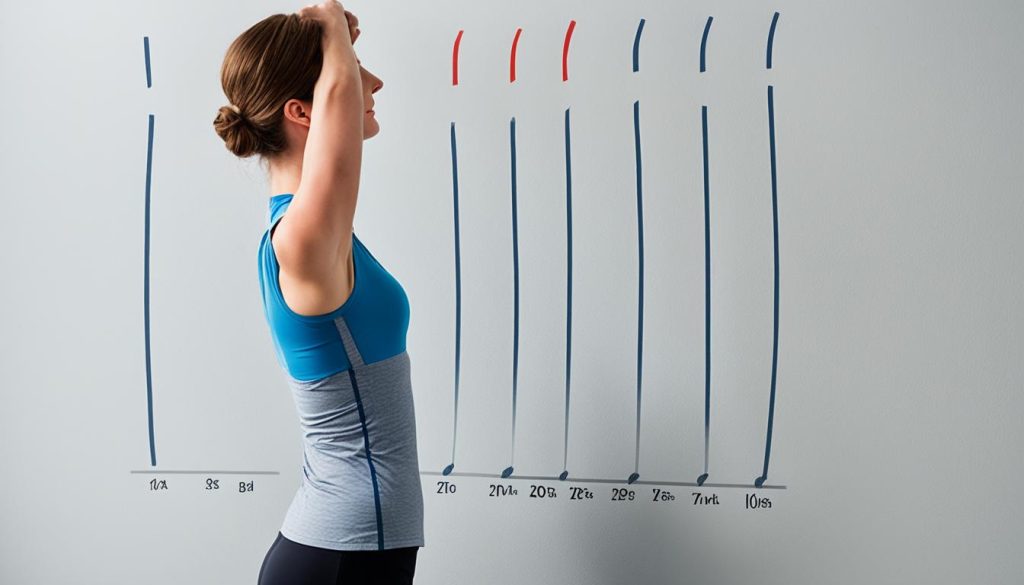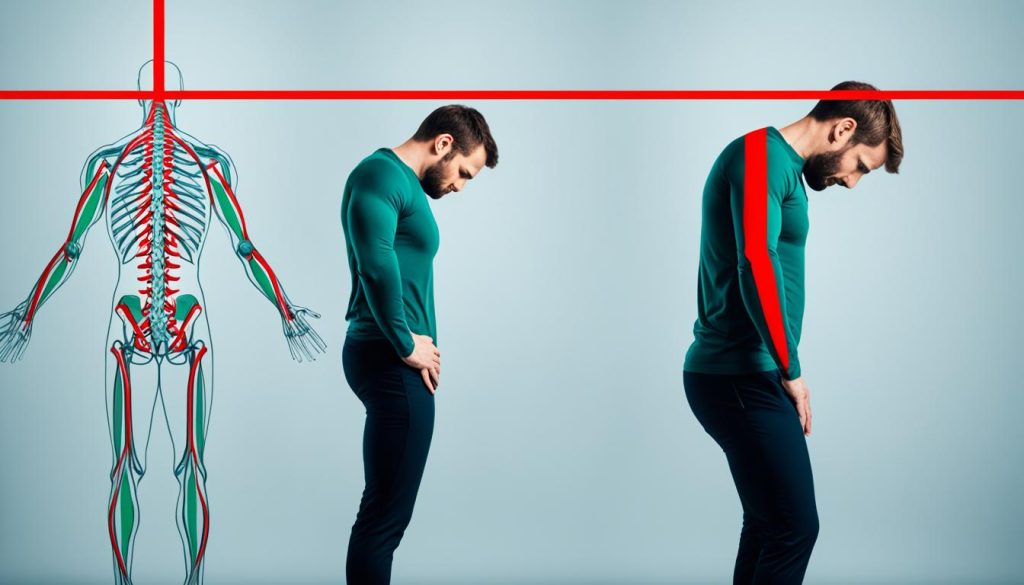Ever wondered if standing and sitting up straight could be the key to preventing chronic back pain? You might be surprised at how much your posture affects your back health. Proper alignment of the spine is crucial for avoiding discomfort and securing long-term musculoskeletal benefits.
Discover how simple posture tips can lead to effective pain prevention strategies. These tips can significantly improve your quality of life.
Quick Recommendation: Our blog guides you through the importance of posture in preventing back pain. If you want to dive into the subject of back pain more comprehensively, we recommend The Back Pain SOS - eBook.
Why Posture Matters for Your Spine Health
Good posture is key when we talk about spinal alignment. Your spine naturally curves to absorb shock and spread out your weight evenly. Slouching or hunching messes with these curves, putting stress on your spine and the tissues around it. This can cause discomfort, pain, and even lead to conditions like osteoarthritis.
Good posture does more than just help with back pain. It makes sure your nerves work right, which boosts your overall health. People with good posture often have fewer nerve problems, like sciatica.
Plus, good posture makes your muscles work better. When your spine is in line, your muscles don’t get as tired. This reduces muscle damage and improves your health over time.
So, good spinal alignment is more than just standing up straight. It keeps your spine healthy and boosts your quality of life.

Common Posture Mistakes Leading to Back Pain
Many people have chronic back pain because of simple posture mistakes they make every day. Slouching is a big one, putting too much pressure on your spine. This can cause muscle imbalance and back pain over time.
Forward head posture is another big issue. It happens when your head sticks out too far, straining your neck and upper back muscles. It’s common in people who work at computers for long hours. Knowing about this can help you fix it.

Uneven weight distribution is also a posture error. People often lean to one side, causing muscle imbalance and making back pain worse. To avoid this, make sure to stand or sit evenly on both feet.
Dr. Stuart McGill, a top expert in spine biomechanics, says it’s key to spot these posture mistakes in our daily lives. By avoiding slouching, fixing forward head posture, and keeping weight even, you can help prevent back pain.
How to Identify Poor Posture
Knowing how to spot poor posture is key for keeping your spine healthy and feeling good overall. A detailed check of your posture can show you where you might be slouching and boost your awareness of your body. Here’s how to check your posture by yourself at home.

Step 1: Use a Mirror
Begin by standing in front of a full-length mirror. See if your shoulders are even or if one is higher than the other. Check if your head is in line with your body or if it leans forward. This first look can show you if your posture is off.
Step 2: Check Your Profile
Turn to your side and look at your profile in the mirror. Look for a bulging belly, rounded shoulders, or a curved lower back. These are clear signs you need to work on your posture.
Step 3: Use Photos
Ask a friend to take pictures of you standing and sitting from the front, side, and back. Look at these photos to see any unevenness or misalignment. Photos give you a closer look and can help you pay more attention to your posture.
Step 4: Assess Your Sitting Posture
Sit in a chair with your feet flat on the floor. Make sure your back is straight and your shoulders are relaxed. If you find yourself slouching or leaning forward, it’s a sign you might have poor posture.
Experts in health and fitness suggest checking yourself often for signs of bad posture. Adding these steps to your daily routine can greatly improve your awareness of your posture. It also helps you keep a better posture all day.
Corrective Ways to Improve Your Posture
Improving your posture starts with simple steps. First, check how you sit. Make sure your chair supports your lower back and your feet are flat on the ground. This helps spread your weight evenly and keeps you aligned.
Wearing supportive shoes is key for better posture. Shoes with good arch support ease back strain and help you stand tall. If needed, think about getting orthotic inserts.

Talking to physical therapists can help you improve your posture. They suggest exercises to strengthen your core. A strong core is vital for good posture. Simple exercises like chin tucks and shoulder blade squeezes help keep you aligned all day.
Make healthy posture habits part of your daily life. Small changes, like setting your screen at eye level and stretching often, can make a big difference. Always be aware of your posture, whether you’re sitting, standing, or lying down, to keep up these good habits.
Workplace Ergonomics and Posture

When thinking about office health, focus on workplace ergonomics for a healthy sitting posture. Ergonomic furniture, like standing desks and supportive chairs, helps prevent back pain. These items keep your spine in line, making work easier without strain.
Experts in occupational health say an ergonomic workspace is key. Adjust your chair so your feet rest flat, knees are at 90 degrees, and your screen is at eye level. This setup supports your sitting posture and boosts your office health all day.
Quick Recommendation: Our blog guides you through the importance of posture in preventing back pain. If you want to dive into the subject of back pain more comprehensively, we recommend The Back Pain SOS - eBook.
Exercises and Stretches for Better Posture
Improving your posture is key for back health and overall well-being. Adding posture exercises and a regular stretching routine can boost your core strength. This helps support your spine and ease muscle tightness. Here are some top movements to try.
Cat-Cow Stretch: This stretch warms up your spine and eases tension in your upper body. It also boosts flexibility. Start on your hands and knees. Arch your back up towards the ceiling (Cat), then bend it down towards the floor while lifting your head (Cow).
Plank: Planking does more than build abs; it strengthens your core. This is vital for good posture. Hold a straight line from head to heels. Make sure to engage your abs, glutes, and shoulders at the same time.
Child’s Pose: Yogis love this pose for stretching the lower back and shoulders. Sit back on your heels with your arms out in front. Let your torso relax over your thighs.
Bridge: Start by lying flat on your back with knees bent and feet hip-width apart. Lift your hips up towards the ceiling. While doing this, squeeze your glutes and engage your core. This strengthens your lower back and helps keep your spine in a neutral position.
Shoulder Rolls: To fight the effects of sitting at a desk all day, add shoulder rolls to your routine. Roll your shoulders up, back, and down to release tension.
Adding these exercises and stretches to your daily routine will strengthen your core and help keep your spine aligned. Remember, being consistent is key to seeing results and avoiding back pain in the future.
Posture Corrective Devices and Tools
Keeping a good posture can be tough, but using posture aids daily can really help. Let’s look at some top devices and tools to improve your posture and ease back pain.
Back braces are a great choice. They support your spine and help you stay straight all day. They’re perfect for desk work or being on the go, giving you the support you need for a healthy spine.
Ergonomic supports, like cushions and chairs, also promote better posture. They match the natural curve of your spine, easing back muscle strain. These are great for office jobs where sitting for hours is common.
Technology has given us posture corrector apps for smartphones and tablets. These apps send reminders and exercises to help you check and better your posture. With daily exercises, these aids can train your body to stand and sit better.
Choosing the right posture aid depends on your needs. Back braces are ideal for extra spinal support, while ergonomic supports are best for work settings. Posture corrector apps are perfect for those who need constant reminders and structured exercises.
Always talk to medical experts to see which devices suit you best. Using these tools correctly can greatly improve your back health and overall wellness.
Importance of Regular Physical Activity
Regular physical activity is key for keeping your posture and spine healthy. Being active strengthens muscles that support your spine, lowering back pain risks. Health groups suggest mixing different exercises for best benefits.
A sedentary life raises the chance of back pain. Stay active with walking, swimming, or yoga to keep your spine healthy. Exercise keeps muscles flexible and joints working well.
The American Heart Association recommends 150 minutes of moderate exercise weekly. Add muscle-strengthening activities on two or more days. This plan boosts physical and back health. Make exercise a habit to help your posture and spine.
The Psychological Impact of Good Posture
Good posture is more than just a physical habit. It deeply affects your mental health. Studies show that standing tall can make you feel happier and more well.
When you sit or stand upright, you tell your brain you’re confident and capable. This lifts your self-esteem and confidence, making you feel great.
Good posture also changes how others see you in both personal and work settings. People see upright people as more confident and skilled. This can make your social and work life better.
Good posture can fight anxiety and depression. Straightening your back and lifting your chin can make you feel better. Posture and psychology are linked; improving one helps the other.
Adding posture correction to your daily life can boost your mental health for a long time. It makes you more confident and changes how you interact with others. You seem more lively and involved.
So, next time you want to slouch, remember. Good posture is a key to better mental health and psychology.
Conclusion
Taking care of your posture is key to preventing back pain and keeping your spine healthy. If your posture is off, it can cause a lot of pain and lead to ongoing problems. By spotting and fixing bad postures, you can help yourself.
There are steps you can take to improve your posture. Doing exercises and stretches can help you stand up straight. Also, making your workspace more ergonomic, like adjusting your chair and desk, is important. Using tools to help correct your posture can also make a big difference.
Staying active and knowing how good posture helps your mind can also help you keep up with these healthy habits. Make sure to focus on your posture every day. Doing so will lead to a pain-free back and a healthier, happier life.
Quick Recommendation: Our blog guides you through the importance of posture in preventing back pain. If you want to dive into the subject of back pain more comprehensively, we recommend The Back Pain SOS - eBook.

